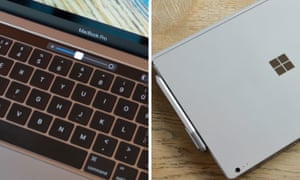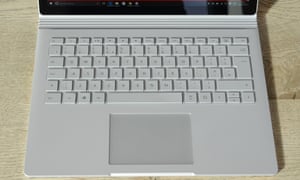
I’ve been an Apple user for over a decade, ever since I picked up a refurbished 17in PowerBook back in 2005 to replace my ailing Windows XP box. But last month, after Apple announced its most expensive new MacBook Pros in almost 15 years, I reconsidered my decision for the first time and, for the past few weeks, I’ve been back on a Windows PC.
I wasn’t always a Mac user. My first three computers were PCs, although the house I grew up in had an ailing, hated Power Mac Performa. My reasons for switching in my teens were fairly simple: I’d been playing fewer and fewer PC games, and spending increasing amounts of time using my computer to manage the music library linked to my iPod. I was one of those switchers, surprised by the elegance of Apple’s music player and convinced to take the plunge into their full desktop operating system.
The laptop wasn’t cheap, but it made shuttling between my separated parents’ houses much easier. And while I missed being able to play the full library of PC games I’d built up over the years, it was an exciting time to be moving to the Mac OS world. Plus, World of Warcraft was cross-platform, which was all the gaming I needed for a good while.
Ten years on, I’m a fairly default Apple user. I’m on my sixth iPhone, second iPad and third Mac; I have an Apple TV at home, Apple branded keyboard on my desktop, and even an Apple AA battery charger, from the days when they made them.
But the twin punches of a Brexit-led depreciation of the pound, and Apple releasing a new range of MacBook Pros with the least bang-for-your-buck in recent memory, made me think twice. The cheapest Mac that would be sufficient for my needs, a 13in MacBook Pro with 512GB of storage space and 16GB of ram, comes in at well over £2,000, yet is barely more powerful than the machine it’s replacing, a 15in retina MacBook Pro from four years ago that cost just over £1,500 at the time.
So I switched back. For the past month, I’ve been using the Surface Book, the top-of-the-line laptop sold by, of all people, Microsoft.
It’s been an experience.
Great-ish expectations

My expectations going in were uncertain. I know Windows has evolved radically since I last used it, back in the XP era, and has even changed since the last time I used it in anger, shortly after the launch of Windows 8.1. The current latest version of the operating system, Windows 10 (confusingly, only one version later than 8.1; the story goes that too many developers wrote code referring to Windows 95 and 98 as “9*”, meaning an actual Windows 9 would break compatibility), is generally considered a good thing. It meshes the new Windows experience of version 8 with an old-style desktop more elegantly than previous versions, while consigning ever more of the cruft deep into nested menus and offering a slick experience for first-time users.
I was also given hope by the machine. After an awkward start with the first version of the Surface back in 2012, then pitched as an iPad competitor, Microsoft has become one of the best manufacturers of Windows PCs there is. The Surface Book is a delicious machine, masquerading as a MacBook Pro-class laptop but with a fully detachable touchscreen that opens it up to a whole new range of uses.
The quality of the Surface machines has caused problems when it comes to Microsoft’s relationships with its hardware partners, who tended to expect Microsoft to be content raking in millions with the licensing fees for Windows, rather than competing with them directly for profit from hardware manufacturing. But for now, the company has been content to sit on the edge of the market, making niche devices for the power user.
Despite all of that, I had a fair amount of trepidation. Memories of blue screens of death, of driver conflicts, of cleaning out my registry and restoring the system after a malware infection, are hard to shake, as is the general hangover from my youth of Microsoft as the Great Satan of the tech world. As Zuckerberg is to the 2010s, Gates was to the 1990s: ever-present, professionally amoral, and incredibly, unflappably, successful.
But Gates is gone, as is Ballmer. This is Satya Nadella’s company now, and the Microsoft of this generation is everything the Microsoft of the 90s – or the Facebook of today – isn’t: humble, quiet, content with success where it can win and partnerships where it can’t, and as proud of working with competitors as Gates was of crushing them. In short, it’s a Microsoft that I could consider being friends with. It couldn’t be that bad.
Switching pains
The worst thing about switching, it turns out, is switching.
I’m not trying to be tautological. But the bulk of the unpleasantness I’ve experienced actually making this change hasn’t been inherent to Windows, but has either come about because of the differences between the two operating systems, or even just the difficulties in actually getting up and running from day one.
Some of the problems are as simple, but nonetheless infuriating, as different keyboard shortcuts. A lifetime of muscle memory has told me that Command-Space brings up Spotlight, which is the main way I opened programmes on my Mac. The same shortcut on Windows 10 is to simply hit the Windows key, which invokes Cortana, Microsoft’s AI assistant, and then typing in the name of the programme you want to open.
